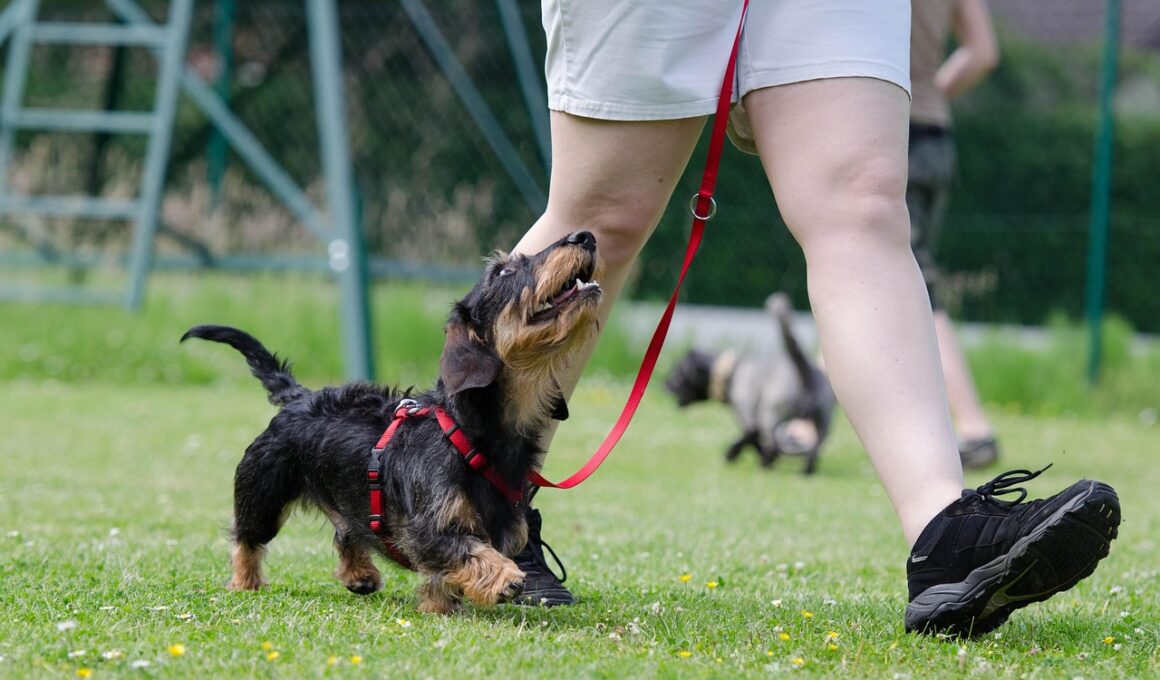Creating Customized Training Plans Based on Journal Insights
When embarking on the journey of dog training, understanding each dog’s unique needs is crucial. A customized training plan becomes integral for accommodating these needs effectively. Leveraging insights from training journals allows trainers and dog owners to comprehend the dog’s progress, strengths, and areas needing improvement. A journal serves not only as a record but as a valuable tool for reflection, helping identify patterns over time. For instance, noting behavioral responses to certain commands aids in adjusting training strategies accordingly. Activation of the training plan can then be tailored based on what has been documented. These insights can warn the trainer about potential pitfalls and mistakes, helping prevent retraining or misuse of techniques. By monitoring the dog’s response to commands and adjustments, the trainer can utilize specifics to optimize future sessions. Furthermore, tracking timelines for each command or behavior allows for precise evaluations on effectiveness. In essence, a training plan rooted in observations and tailored adjustments ensures a successful training experience for both the dog and owner, enriching their bond through structured learning and clear communication.
One effective method in fostering progress tracking is through a detailed recording format. A well-structured journal can emphasize clarity in progress. Many training journals can incorporate sections for daily reflections, specific goals, and achievements. Dedicating space to note observations allows owners to pull patterns out more easily, aiding in future planning. There are various approaches, but all hinge on consistency. Different colors can signal various themes in the training process. For example, blue can indicate success, while red may highlight challenges. Each entry should convey succinct reflections on the day’s training, including emotions and situational contexts. This way, when looking back at a period of training, patterns emerge clearly. Owners can pinpoint which methods lead to successful outcomes and which ones need revamping. In this sense, training documentation transforms into proactive update sessions, where approaches are adaptively fine-tuned. Journals foster a reflective dialogue between pet and owner, igniting innovative approaches to everyday challenges. These logs establish a feedback loop primarily reflective of the dog’s capacity to learn, thrive, and bond with their owner, emphasizing the training journey’s collaborative effort.
Strategies for Creating Personalized Training Plans
As you compile your insights from training journals, it’s beneficial to categorize these insights into actionable strategies. For instance, based on previous successes, consider what triggers your dog’s best performance. If a specific training environment leads to plus results, replicate that setting as often as possible. This process of aligning strategies with the dog’s inclinations involves deliberate planning. A personalized training plan must take into account particular responses to commands and adjust teaching techniques accordingly. Visual cues or gentle physical gestures might resonate better with certain dogs. Moreover, plan the frequency of sessions to suit your pet’s energy levels. Too many sessions can lead to frustration, while too few may hinder progress. Assess which commands cause frustration or joy and modulate the training intensity. Incorporating breaks and varied exercises can maintain engagement and interest. It’s vital to frequently reassess and mold the plan to prioritize both the owner’s confidence and the dog’s enjoyment in learning. Each plan should evolve with the dog’s growth, which means that journal entries become critical pieces of actionable direction, fostering improvement and success.
Equally important in this process is the incorporation of positive reinforcement. Documenting how your dog reacts to different forms of reward enables effective engagements. Identifying what motivates your dog, be it treats, play, or praise, empowers you to tailor the reinforcement methods. Successful reinforcement based on earlier recordings encourages further good behavior, instilling confidence and enthusiasm in the dog. Timing is paramount when implementing rewards, as immediate reinforcement can solidify the desired behavior dramatically. Insights from past training engagements typically highlight the most effective rewards, allowing trainers to craft an enticing reward system. Additionally, recognizing signs of stress or frustration during sessions can be crucial. A skilled trainer understands when to adjust methods based on emotional and behavioral cues noticed in journals. Ultimately, the cornerstone of any training plan consists of responsive adaptations tailored to the dog. By being aware of the nuances revealed through observations, trainers establish a more compassionate strategy that enhances the dog’s learning experience. A balance of structure and spontaneity ultimately leads to a productive training environment, ensuring that both the trainer and the dog achieve their goals harmoniously.
Maintaining Consistency in Training Plans
Consistency is a cornerstone of effective dog training, and this principle should resonate throughout the personalized training plan. Journals can help maintain consistency by documenting the frequency, duration, and type of training sessions performed. Those logs allow owners to be accountable for their routines, showcasing patterns in adherence to the training schedule. Regularly revisiting training goals ensures that they remain clear and achievable, fostering a sense of accomplishment as milestones are accomplished. Documentation and reflection encourage re-evaluation and persistence over time, mitigating the tendency to wander through different routines. A structured approach facilitates habit-forming for both the dog and trainer. Recorded timelines reveal insights into the effectiveness of varying techniques under changing circumstances. Additionally, it’s advantageous to have a system in place for tracking the consistency of commands, cues, and rewards. In circumstances where behaviors falter inexplicably, journals can act as a diagnostic tool. By analyzing what has worked well before, a better framework emerges, keeping the training process steady, reliable, and dynamic. Communication between the owner and dog remains open, helping to fortify respect and understanding.
Flexibility is often overlooked but is equally crucial in a personalized training plan. Dogs, like humans, have their days where things simply don’t go right due to outside factors. Dog trainers must authentically assess what works and adapt as necessary rather than rigidly adhering to the initial strategy. Every entry provides a deeper understanding of the dog’s behavior, leading to spontaneous adjustments. A good trainer ideally recognizes the flow of training and is willing to pivot strategies based on their observations. When a plan becomes too prescriptive, it may hamper the excitement dogs have during training. Instead, integrating playful elements and diversification can both engage the dog and allow for adaptations based on prior reflections. Mixing activities, such as play, socialization, or introducing new routines, helps prevent monotony and reinforces healthy learning. In essence, agility is about pacing oneself alongside the dog’s evolving learning curve. An adaptable plan promotes the most fruitful outcomes, ensuring training remains enjoyable and fulfilling, nurturing a connection between trainer and dog that thrives on trust and understanding.
Evaluating and Revising Training Plans
Finally, the importance of regular evaluation cannot be understated. The training journey represents an opportunity for ongoing review and modification based on the dog’s progress. Examining journal entries illuminates which techniques resonate or falter. Gathering this data weekly allows the trainer to assess both the dog’s achievements and setbacks. Setting brief evaluation periods enables the assessment of broader trends rather than focused reviews. Recognizing the evolution of behaviors over time enhances the effectiveness of planned adjustments. For example, identifying consistent success or struggles with specific commands provides actionable insights for future sessions. On one hand, if a dog continually excels in a command, revisiting the rewards or incorporating new challenges becomes essential. Conversely, if a command proves frustrating, altering the approach could prove invaluable. Each adjustment can be recorded in the journal for thorough reflection. This reflective practice ensures that training remains a dynamic process tailored to both the dog and the trainer’s growth. Ultimately, a commitment to evaluation fosters a more enriching experience for both, creating a roadmap toward well-rounded, effective dog training.


